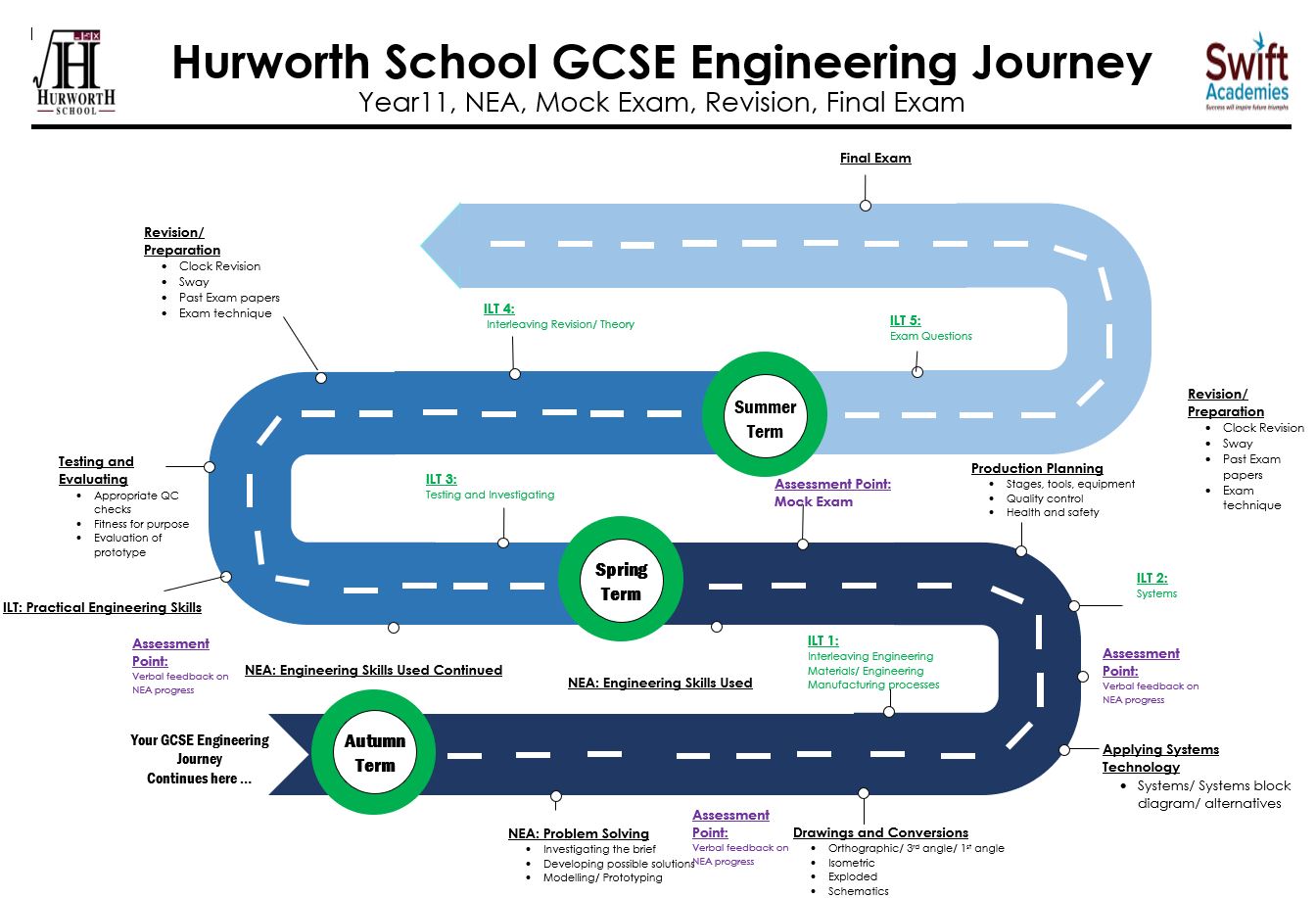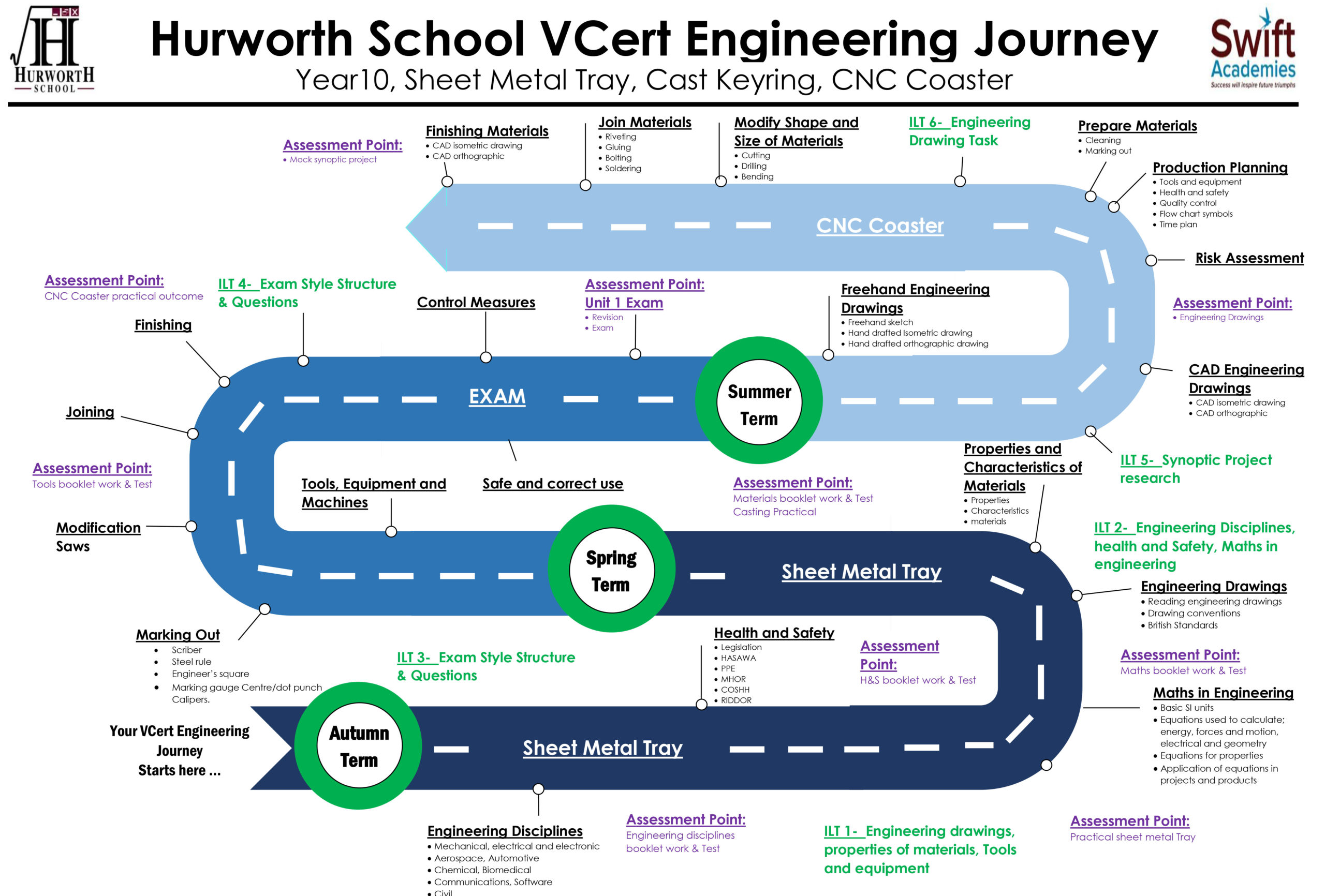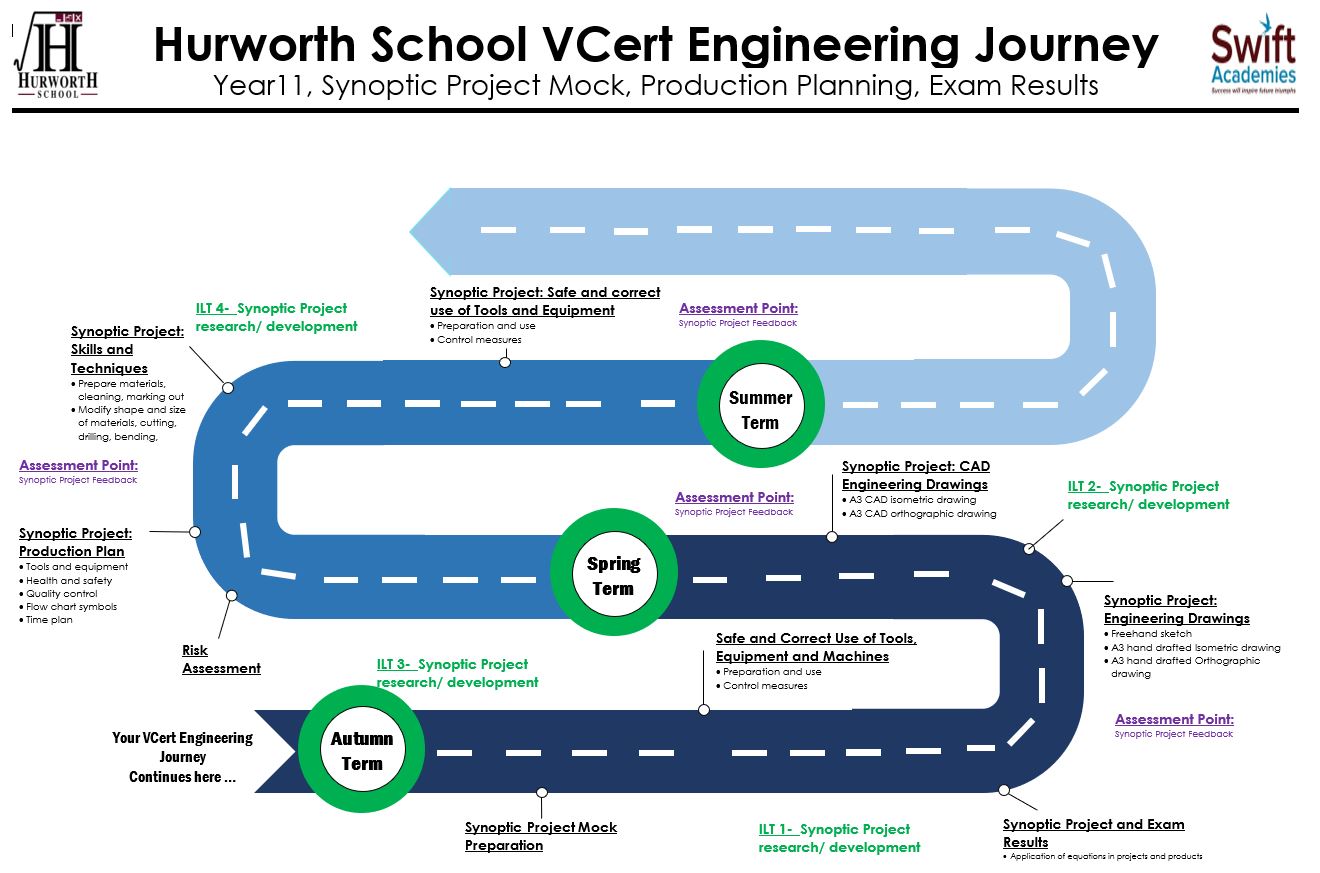Why do we study Engineering?
Within our Design & Technology curriculum our students will also focus on principles of engineering. Engineering allows students to become problem solvers and creative thinkers, solving real life problems and gaining transferable skills and techniques that can be used in many different career paths. The knowledge they gain will let them see how the world around them has been engineered through different materials, processes and technology. In Key Stage 3 students will gain an insight into these principles. Then, depending on their learning styles and strengths, they can choose from two Key Stage 4 engineering courses, both of which offer the building blocks to progress to further study a career in engineering.
Year 7
Learning Outcomes
In Year 7, students will explore key principles of engineering to develop their understanding of theory and practical application. Students will work with a range of engineering materials and use different modern and traditional manufacturing techniques during each project. These include hand tools, equipment, and the use of CNC (Computer Numerical Control). Students are encouraged to demonstrate creative thinking, problem solving skills and build on their resilience.
Topics Taught – Pupils study D&T for 1 term in Year 7
Torch project
- Structural systems
- Electronic symbols and components
- Circuit diagrams/ Modelling
- Soldering
Pencil Topper
- Designing
- Modelling
- CAD/ CAM/ CNC
- Manufacturing Processes

DT – KS3 – Read and watch list
Year 8
Learning Outcomes
In Year 8, students are encouraged to develop precision and accuracy in their work. Quality and application of engineering knowledge are at the forefront of each Scheme of Work.
Students will develop confidence from their previous learning and strive to work independently to create final solutions with high quality and accuracy within specified tolerances. The use of quality control, including physical and visual checks will support them in this process.
Topics Taught
Electronics- Mini speaker
- Materials
- Sustainability/ Environment
- Electronic symbols and components
- Soldering
- Practical skills
- Engineering systems
Programmable Devices- Microbit Pet
- Programmable devices
- Input/ process/ output
- Hardware and software
- CAD CAM
- Testing and evaluation

DT – KS3 – Read and watch list
Year 9
Learning Outcomes
In Year 9, students have the opportunity to explore how to solve real life engineering problems. Theyn will focus on how environmental impact can be reduced, and the impact that new and emerging technology has.
Furthermore, students will develop their knowledge and understanding of engineering systems such as mechanical and electrical/ electronic can be integrated to solve problems.
They will also learn how to generate, read and interpret engineering drawings and schematics.
Students will be assessed on their practical outcome that will be electro-mechanical, and through their modelling, drawings and schematics.
Topics Taught
Electric motor car challenge
- Design brief/ task analysis
- New and emerging technologies
- Engineering drawings and schematics
- Virtual and physical modelling
- Manufacturing Processes
- Jigs and templates
- Objective testing (race)

DT – KS3 – Read and watch list
GCSE ENGINEERING
Year 10
Exam Specification
GCSE Engineering
AQA Specification
https://www.aqa.org.uk/subjects/engineering/gcse/engineering-8852
Learning Outcomes
- Outcomes: Sheet metal tray/ skills board
- Outcomes: Bike alarm/ solar vehicle
- Outcomes: CNC Coaster (Aluminium, Acrylic and Neoprene)
Topics Taught
Autumn Term
Engineering Materials
- Materials and their properties
- Material costs and supply
- Factors influencing design solutions
Engineering Manufacturing Processes
- Additive manufacturing
- Material removal
- Shaping, forming and manipulation
- Casting and moulding Joining and Assembly
- Heat and chemical treatment
Surface finishing
Spring Term
Systems
- Describing systems
- Mechanical systems
- Electrical systems
- Electronic systems
- Structural systems
- Pneumatic systems
Testing and Investigation
- Modelling and calculating
- Testing
Aerodynamics
Summer Term
The impact of Modern Technologies
- The impact of modern Technologies
Practical Engineering Skills
- Problem solving
- Engineering drawings and schematics
- CAD, CAM and CNC
- Testing materials and production plans
- Predict performance using calculations and modelling
Select and use materials, parts, components, tools and equipment

DT – KS4 – Read and watch list
Year 11
Exam Specification
GCSE Engineering
AQA Specification
https://www.aqa.org.uk/subjects/engineering/gcse/engineering-8852
Learning Outcomes
Throughout Year 11 students will complete their device / system in response to the NEA brief. Students will be given criteria for each section, so that they can optimise their marks and overall grade. Remaining time will be used to prepare for their forth coming summer exam.
Topics Taught
Autumn Term
NEA
- Problem solving
- Drawings and conventions
Applying systems technology
Spring Term
NEA and Mock
- Production planning
- Engineering skills used Testing and evaluating
Exam Preparation
- Revision
Summer Term
Exam Preparation
Revision

DT – KS4 – Read and watch list
VCERT TECHNICAL AWARD IN ENGINEERING
Year 10
Exam Specification
Engineering
VCERT Technical Award Level 1/2
Learning Outcomes
- Term 1 – Understanding the engineering world
- Outcomes: Sheet metal tray/ Bike alarm
- Pupils will also generate an orthographic engineering drawing and isometric Engineering drawing of their sheet metal tray
- Term 2 – Bridge Design and make/ coaster
- Term 3 – Skills board
Topics Taught
Autumn Term
Engineering Disciplines
- Mechanical
- Electrical and electronic
- Aerospace
- Communications
- Chemical
- Civil
- Automotive
- Biomedical
- Software
Health and safety
- Health and safety legislation: HASAWA
- PPE Regulations
- MHOR
- COSHH
- RIDDOR
Maths in Engineering
- Application of basic SI units in projects and products
- Equations in Engineering
Engineering Drawings
- Reading Engineering Drawings
Properties and Characteristics of Materials
- Properties and Characteristics of Materials
Spring Term
Tools and Equipment
- Tools
- Equipment and Machines
- Safe and Correct Use
Unit 1 Exam
- Revision for Unit 1
- First exam attempt March
Summer Term
Synoptic Project Mock (Unit 2 Preparation)
Learning Objective 1
- Produce hand drawn engineering drawings
Learning Objective 2
- Produce Computer Aided Design (CAD) engineering drawings
Engineering drawings
- An A3 CAD isometric drawing sheet
Learning Objective 3
- Demonstrate production planning techniques
Production planning
Skills and techniques
- Prepare materials
- Cleaning
- Marking out
- Modify shape and size of Materials-Cutting
- Drilling
- Bending
- Casting
- CAM
- Join materials -riveting, gluing, bolting, soldering
- Finish materials – filing, sanding, polishing
Applying a surface finish

DT – KS4 – Read and watch list
Year 11
Exam Specification
Engineering
VCERT Technical Award Level 1/2
Learning Outcomes
In Year 11 students will begin their synoptic project. The brief for this will be provided by NCFE and will give students the opportunity to demonstrate and apply their knowledge. Furthermore, students who need to improve on their previous exam grade will be given the opportunity to re-sit.
Topics Taught
Autumn Term
Synoptic Project Mock (Unit 2 Preparation) Attempt 2 from feedback
Safe and Correct use of Tools, Equipment and Machines
- Preparation and use control measures
Synoptic project and exam resits
Learning Objective 1
- Produce hand drawn engineering drawings
Engineering drawings
- A freehand sketch
- An A3 hand drafted isometric drawing sheet
- An A3 hand drafted orthographic drawing sheet
Spring Term
Learning Objective 2
- Produce Computer Aided Design (CAD) engineering drawings
Engineering drawings
- An A3 CAD isometric drawing sheet
- An A3 CAD orthographic drawing sheet
Learning Objective 3
- Demonstrate production planning techniques
Production planning
- Risk Assessment
- Production plan
- Tools and equipment
- Health and safety
- Quality control
- Flow chart symbols
- Time plan
Skills and techniques
- Prepare materials
- Cleaning
- Marking out
- Modify shape and size of Materials – cutting, drilling, bending, casting, CAM
- Join materials – riveting, gluing, bolting, soldering
- Finish materials – filing, sanding, polishing, applying a surface finish
Safe and Correct use of Tools, Equipment and Machines
- Preparation and use control measures
Summer Term
Complete Course




